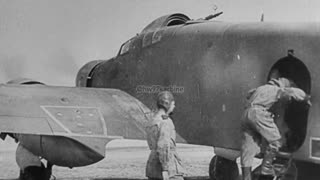Premium Only Content

High speed footage of Japanese autocannon trials in the 1930s
In 1935, officers in the Imperial Japanese Navy began to investigate 20mm automatic cannon as armament for future fighter aircraft. Their attention was drawn to the family of aircraft autocannon manufactured by Oerlikon, the FF, FFL and FFS. These all shared the same operating principle, the advanced primer ignition blowback mechanism pioneered by the Becker cannon, but fired different ammunition: 20×72RB, 20×101RB, and 20×110RB, respectively.
Following the import and evaluation of sample guns, the Imperial Japanese Navy decided in 1937 to adopt these weapons. To produce the Oerlikon guns, a group of retired Navy admirals created a new arms manufacturing company, the Dai Nihon Heiki KK. In 1939 this started producing a Japanese version of the FF, initially known as the Type E (because the Japanese transliteration of Oerlikon was "Erikon") but from late 1939 onwards formally known as the Type 99 Mark 1. A Japanese version of the FFL was produced as the Type 99 Mark 2.
Unlike most high-powered autocannons, the Oerlikon and its derivatives have a blowback mechanism: the bolt is not locked to the breech of the gun at the moment of firing. Non-locking, simple blowback designs are commonplace in much lighter weapons, such as small-caliber semi-automatic pistols. No locking is required, as with such low-power cartridges the static inertia of the bolt or bolt and slide - the physical tendency of heavy components to resist rapid acceleration - is adequate to ensure that the projectile has left the muzzle and the gas pressure in the barrel is down to a safe level before the breech opens. While the bolt spring also resists the opening of the breech, in practical terms its contribution is too small to be relevant.
In contrast, 20mm cartridges are far too powerful, and efficient autocannon barrels too long, for this basic system to be practical; so the Oerlikon uses Advanced Primer Ignition (API) to augment the resistance of the bolt. In API blowback weapons, the firing pin fires the cartridge while the bolt is still traveling forward so that the gas pressure has to overcome the forward momentum of the bolt as well, before it can push it to the rear. To facilitate this, the Oerlikon's chamber is longer than needed to contain the cartridge, and the front-end of the bolt, which is the same diameter as the case, actually enters this extended chamber behind the cartridge before firing. As a result when firing occurs, the forward force of the bolt and spring acts against the force of the propellant gases until the latter overcome the former and start pushing case, bolt and spring backwards. If the bolt had stopped at the mouth of the chamber as in a simple blowback gun, this momentum would have been neutralized; instead thanks to the continuous movement the momentum acts to counter the propellant gases and slow the rearward travel of cartridge and bolt.
A second advantage of this unusual arrangement is that after firing the bolt and case have a short, but significant, distance to travel rearwards before the bolt-end re-emerges and the case in turn begins to leave the chamber; and this in combination with the retardation of the rearward travel provides sufficient time for gas pressure to drop to the necessary safe level. This system permits blowback to be used in far more powerful weapons than normal. Nevertheless, compared to guns with a locking mechanism, a fairly heavy bolt must be employed, and to give this heavy bolt sufficient forward speed, a correspondingly large spring is required to drive it. In the case of the Oerlikon having this spring concentric with the barrel is a distinctive feature.
-
 1:00
1:00
hw97karbine
8 days agoItalian Savoia Marchetti SM.79 bombers attack British shipping in the Mediterranean in 1940
40 -
 1:27:57
1:27:57
Tucker Carlson
7 hours agoTucker and Col. MacGregor Warn How Neocons Are Exploiting the Drug Crisis to Drag America Into War
39.3K150 -
 2:08:50
2:08:50
Badlands Media
12 hours agoDevolution Power Hour Ep. 402: Arctic Frost, Trump’s Third Term & The G2 Showdown
92.7K56 -
 2:05:48
2:05:48
Inverted World Live
11 hours agoUFO Seen Over Tokyo During Trump Visit | Ep. 132
69.5K21 -
 2:54:08
2:54:08
TimcastIRL
9 hours agoDemocrat FEDERALLY INDICTED For Obstructing ICE Agents In Chicago | Timcast IRL
225K110 -
 7:17:25
7:17:25
SpartakusLIVE
11 hours agoNEW - REDSEC Battle Royale || The Duke of Nuke CONQUERS ALL
52.7K9 -
 2:38:39
2:38:39
PandaSub2000
1 day agoNintendo DS Night | ULTRA BEST AT GAMES (Original Live Version)
31.9K25 -
 4:05:07
4:05:07
Alex Zedra
8 hours agoLIVE! Battlefield RecSec
36K9 -
 1:26:50
1:26:50
The Quartering
9 hours agoErika Kirk Threatened, SNAP Riots Near, & New AstroTurfed Woke Lib Influencer
68.5K35 -
 29:24
29:24
Glenn Greenwald
11 hours agoSen. Rand Paul on Venezuela Regime Change, the New War on Drugs, MAGA Rifts, and Attacks from Trump | SYSTEM UPDATE #539
138K126